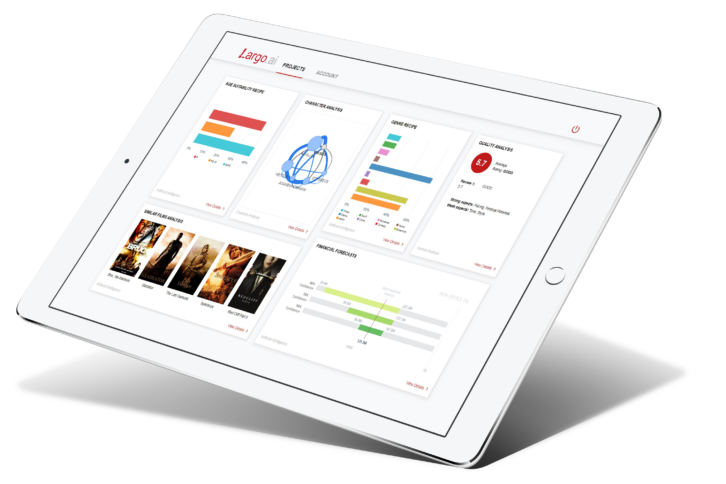When the esteemed Collins Dictionary named AI as its 2023 Word of the Year – despite it not even being a proper word at all – the publisher said that the use of the term had quadrupled in 2023. It added that AI “has quickly become as ubiquitous and embedded in our lives as email, streaming or any other once futuristic, now everyday technology.”
The Collins Dictionary is not wrong. AI is squeezed into everything, it’s inescapable, and AI’s widespread adoption in language means that it already has a fearsome reputation. But Largo.ai CEO and co-founder Sami Arpa believes it’s not coming for our jobs. On the contrary, it is helping creatives to produce better content and is supporting independent filmmaking.
Here to help
With a PhD in computational aesthetics, Arpa has been doing scientific research into AI since 2015. Around the same time, he was also writing and directing his own short films and eight years ago he started a film festival in Switzerland to help him understand the creative process even better. All these things came together in 2018 when he started Largo.ai with the focus of providing AI services for the movie and TV industries.

“In 2018 the likes of Netflix and Amazon were already using more data-assisted intelligence and it was clear that this would change significantly over the next few years. We started Largo.ai with the focus of providing AI services for the movie and TV industries and it is applicable wherever there is a story to be told on video,” he explains.
“Our typical clients are producers and studios, and they are engaging with us as soon as there is a treatment for the content because our tools help develop ideas for positioning, characters and casting, and can even predict expected audiences in terms of demographics and financial results.”
Data’s best friend
Implementing a useful AI strategy is all about interpreting data. AI is a good friend of big data, and the most assistive AI is the analysis and presentation of that data in a way that is the most helpful. For Arpa, this means using AI as a tool that can be used by more people to create better products.
“Many companies who claim to be AI companies are simply creating wrappers over ChatGPT, but here we have developed a core understanding of how AI adds value by contributing to a really specific base,” says Arpa. “It is vital that we develop this alongside our community and all our R&D aims to be in parallel with what the industry wants in order to make useful tools.”
Largo.ai’s tools aim to help producers and filmmakers to best cater for specific audiences and markets based on an analysis of a script and cast. Arpa these tools offer the independent filmmaking industry access to the same cutting-edge analytics as the big studios to not only help create, distribute and market films, but also to make them more attractive to funders and distributors.
In November 2023 the company doubled down on this when it announced a partnership with film distributor Indie Rights, “to improve content evaluation workflows…to bring better independent filmmaker content to the masses faster.”
Levelling the playing field
Arpa says: “A huge advantage of AI is providing opportunities to support the small players as well as the big players. AI provides access to tools normally only available to big studios, and as a result, we will see many more successful films coming from independent producers compared to the past because AI is enabling them to do things that they wouldn’t historically have been able to do.

“Take focus groups; focus groups are expensive and time-consuming, but AI brings a similar level of insight with similar accuracy. It is faster and it is much more affordable and is one example of how many parts of the production chain can benefit across both broadcasting and film development.”
Largo.ai works by creating patterns for genres of content. When a user uploads a screenplay, its software analyses scene-by-scene development and identifies how it compares alongside a database of more than 250,000 films and 150,000 TV shows. It provides genre mapping of any content proposal, suggests tweaks and improvements, predicts demographics and in doing so can help secure funding.
Intangible concepts
“The AI is applying learning across intangible concepts,” Arpa says. “AI can perceive the visual difference between a cat and a dog because they are tangible things, but something like a drama is not, and with no absolute consensus about what a ‘drama’ is, we target the AI to adopt the consensus perception.
“If you took a dramatic piece and asked 200 people about it, 80 per cent of people might agree it is, in fact, very dramatic. That’s also what we bring with AI, the consensus perception.”
By adopting the consensus, AI content mapping can compare a piece of fresh content directly with others in the genre, identify areas where it can be tweaked, and even predict the financial implications.
“We categorise our results into three categories. The first is content positioning; our tools analyse the content and show how it compares to other films in terms of style, pacing and other parameters. There is no subjectivity because the AI provides a neutral voice to ascertain the real positioning,” Arpa continues.
“Secondly, we apply AI to casting. Cast selection is an important part of the process and Largo.ai can suggest actors for casting agents to consider. The user can narrow this search down with filters, but AI can evaluate them and suggest other possibilities.
“The third element is concerned with the audience and financial forecasting, predicting the emotional response of the audience, the development of the audience and the size of the audience in different territories. Combining these results can indicate the financial potential of the content.”
Passive is massive
Crucially, the technology presents everything in a passive way, which Arpa says fits in with the way AI has been adopted in the creative industries.
“We wanted to ensure the AI is as passive as possible, so the AI is just showing different patterns for creatives to decide what to do next. It is not making creative suggestions as much as it is minimising the risk and finding opportunities to make creative tweaks.
“Passive creative suggestion has been a focus from the start. Largo.ai is an assistive tool to make things easier, faster, and less risky. But as technologies like ChatGPT become more commonplace, the AI adoption curve is changing and people’s expectations from AI are changing as well. People we are working with are requesting more of an active role from the AI.”
However it plays out, Arpa’s overall goal is still to enhance the creative process, and while using AI to do that might sound like a contradiction, both he and the Collins Dictionary know it’s not going anywhere.







